Proposal for a Quad-Elliptical Photonic Crystal Fiber for Terahertz Wave Guidance and Sensing Chemical Warfare Liquids
Abstract
1. Introduction
2. Design Geometry and Material
3. Comparison of TE, QE, and PE Geometries
4. Potential of the Proposed Fiber for Use as a Nerve Agent Sensor
5. Fabrication and Practical Feasibility
6. Conclusions
Author Contributions
Funding
Conflicts of Interest
References
- Murphy, J.; O’Sullivan, C. Terahertz Optics. Terahertz Spectroscopy and Imaging 2013, 171, 29–56. [Google Scholar]
- Yin, M.; Tang, S.; Tong, M. The application of terahertz spectroscopy to liquid petrochemicals detection: A review. Appl. Spectrosc. Rev. 2016, 51, 379–396. [Google Scholar] [CrossRef]
- Pan, R.; Zhao, S.; Shen, J. Terahertz spectra applications in identification of illicit drugs using support vector machines. Proc. Eng. 2010, 7, 15–21. [Google Scholar] [CrossRef]
- Woodward, R.M.; Wallace, V.P.; Pye, R.J.; Cole, B.E.; Arnone, D.D.; Linfield, E.H.; Pepper, M. Terahertz pulse imaging of ex vivo basal cell carcinoma. J. Invest. Dermatol. 2003, 120, 72–78. [Google Scholar] [CrossRef] [PubMed]
- Yang, Y. Atmospheric Effects on Free-Space THz. THz Time-Domain Spectroscopy (THz-TDS). J. Laser Opt. Photonics 2014, 1, 1–3. [Google Scholar] [CrossRef]
- Gallot, G.; Jamison, S.P.; McGowan, R.W.; Grischkowsky, D. Terahertz waveguides. J. Opt. Soc. Am. B 2000, 17, 851. [Google Scholar] [CrossRef]
- Hassani, A.; Dupuis, A.; Skorobogatiy, M. Low loss porous terahertz fibers containing multiple subwavelength holes. Appl. Phys. Lett. 2008, 92, 1–3. [Google Scholar] [CrossRef]
- Atakaramians, S.; Afshar, S.; Fischer, B.M.; Abbott, D.; Monro, T.M. Porous fibers: A novel approach to low loss THz waveguides. Opt. Express 2008, 16, 8845–8854. [Google Scholar] [CrossRef]
- Ponseca, C.S., Jr.; Pobre, R.; Estacio, E.; Sarukura, N.; Argyros, A.; Large, M.C.; van Eijkelenborg, M.A. Transmission of terahertz radiation using a microstructured polymer optical fiber. Opt. Lett. 2008, 33, 902. [Google Scholar] [CrossRef]
- Atakaramians, S.; Afshar, S.; Monro, T.M.; Abbott, D. Terahertz dielectric waveguides. Adv. Opt. Photonics 2013, 5, 169–215. [Google Scholar] [CrossRef]
- Uthman, M.; Rahman, B.M.A.; Kejalakshmy, N.; Agrawal, A.; Grattan, K.T.V. Design and characterization of low-loss porous-core photonic crystal fiber. IEEE Photonics J. 2012, 4, 2315–2325. [Google Scholar] [CrossRef]
- Kaijage, S.F.; Ouyang, Z.; Jin, X. Porous-core photonic crystal fiber for low loss terahertz wave guiding. IEEE Photonics Technol. Lett. 2013, 25, 1454–1457. [Google Scholar] [CrossRef]
- Paul, B.; Haque, M.; Ahmed, K.; Sen, S.; Kumar Paul, B.; Haque, M.A.; Ahmed, K.; Sen, S. A Novel Hexahedron Photonic Crystal Fiber in Terahertz Propagation: Design and Analysis. Photonics 2019, 6, 32. [Google Scholar] [CrossRef]
- Islam, M.S.; Sultana, J.; Faisal, M.; Islam, M.R.; Dinovitser, A.; Ng, B.W.-H.; Abbott, D. A modified hexagonal photonic crystal fiber for terahertz applications. Opt. Mater. (Amst) 2018, 79, 336–339. [Google Scholar] [CrossRef]
- Sultana, J.; Islam, M.S.; Faisal, M.; Islam, M.R.; Ng, B.W.H.; Ebendorff-Heidepriem, H.; Abbott, D. Highly birefringent elliptical core photonic crystal fiber for terahertz application. Opt. Commun. 2018, 407, 92–96. [Google Scholar] [CrossRef]
- Krohn, D.A.; MacDougall, T.W.; Mendez, A. Fiber Optic Sensors: Fundamentals and Applications; Spie Press: Bellingham, WA, USA, 2015; pp. 1–332. [Google Scholar]
- Chen, Z.; Hefferman, G.; Wei, T. Terahertz-Range Weak Reflection Fiber Optic Structures for Sensing Applications. IEEE J. Sel. Top. Quantum Electron. 2017, 23, 246–251. [Google Scholar] [CrossRef]
- Hashimoto, M.; Okada, T.; Nishina, S.; Ataka, T.; Shinohara, M.; Maehara, Y.; Irisawa, A.; Imamura, M. Failure Analysis of LSI Interconnection by Terahertz Time-Domain Reflectometry. In Proceedings of the International Symposium on the Physical and Failure Analysis of Integrated Circuits (IPFA), Marina Bay Sands, Singapore, 18–21 July 2016. [Google Scholar]
- De, M.; Gangopadhyay, T.K.; Singh, V.K. Prospects of photonic crystal fiber as physical sensor: An overview. Sensors (Switzerland) 2019, 19, 464. [Google Scholar] [CrossRef] [PubMed]
- Algorri, J.F.; Zografopoulos, D.C.; Tapetado, A.; Poudereux, D.; Sánchez-Pena, J.M. Infiltrated Photonic Crystal Fibers for Sensing Applications. Sensors (Basel) 2018, 18, 4263. [Google Scholar] [CrossRef]
- Islam, M.; Sultana, J.; Rifat, A.; Dinovitser, A.; Ng, B.W.H.; Abbott, D. Terahertz sensing in a hollow core photonic crystal fiber. IEEE Sens. J. 2018, 18, 4073–4080. [Google Scholar] [CrossRef]
- Møller, U.; Cooke, D.G.; Tanaka, K.; Jepsen, P.U. Terahertz reflection spectroscopy of Debye relaxation in polar liquids (Invited). J. Opt. Soc. Am. B 2009, 26, A113. [Google Scholar] [CrossRef]
- Sultana, J.; Islam, M.S.; Ahmed, K.; Dinovitser, A.; Ng, B.W.H.; Abbott, D. Terahertz detection of alcohol using a photonic crystal fiber sensor. Appl. Opt. 2018, 57, 2426–2433. [Google Scholar] [CrossRef] [PubMed]
- Minkovich, V.P.; Villatoro, J.; Monzón-Hernández, D.; Calixto, S.; Sotsky, A.B.; Sotskaya, L.I. Holey fiber tapers with resonance transmission for high-resolution refractive index sensing. Opt. Express 2005, 13, 7609–7614. [Google Scholar] [CrossRef] [PubMed]
- Wu, D.K.C.; Kuhlmey, B.T.; Eggleton, B.J. Ultrasensitive photonic crystal fiber refractive index sensor. Opt. Lett. 2009, 34, 322–324. [Google Scholar] [CrossRef] [PubMed]
- Luan, F.; George, A.K.; Hedley, T.D.; Pearce, G.J.; Bird, D.M.; Knight, J.C.; Russell, P.S.J. All-solid photonic bandgap fiber. Opt. Lett. 2004, 29, 2369–2371. [Google Scholar] [CrossRef] [PubMed]
- Ortigosa-Blanch, A.; Knight, J.C.; Wadsworth, W.J.; Arriaga, J.; Mangan, B.J.; Birks, T.A.; Russell, P.S.J. Highly birefringent photonic crystal fibers. Opt. Lett. 2000, 25, 1325. [Google Scholar] [CrossRef]
- Gangwar, R.K.; Bhardwaj, V.; Singh, V.K. Magnetic field sensor based on selectively magnetic fluid infiltrated dual-core photonic crystal fiber. Opt. Eng. 2016, 55, 026111. [Google Scholar] [CrossRef]
- Yuan, W.; Town, G.E.; Bang, O. Refractive index sensing in an all-solid twin-core photonic bandgap fiber. IEEE Sens. J. 2010, 10, 1192–1199. [Google Scholar] [CrossRef]
- Islam, M.S.; Sultana, J.; Ahmed, K.; Islam, M.R.; Dinovitser, A.; Ng, B.W.H.; Abbott, D. A novel approach for spectroscopic chemical identification using photonic crystal fiber in the terahertz regime. IEEE Sens. J. 2018, 18, 575–582. [Google Scholar] [CrossRef]
- Rana, S.; Kandadai, N.; Subbaraman, H. A Highly Sensitive, Polarization Maintaining Photonic Crystal Fiber Sensor Operating in the THz Regime. Photonics 2018, 5, 40. [Google Scholar] [CrossRef]
- Islam, M.S.; Sultana, J.; Dinovitser, A.; Ahmed, K.; Ng, B.W.H.; Abbott, D. Sensing of toxic chemicals using polarized photonic crystal fiber in the terahertz regime. Opt. Commun. 2018, 426, 341–347. [Google Scholar] [CrossRef]
- Ferraro, A.; Zografopoulos, D.C.; Missori, M.; Peccianti, M.; Caputo, R.; Beccherelli, R. Flexible terahertz wire grid polarizer with high extinction ratio and low loss. Opt. Lett. 2016, 41, 2009–2012. [Google Scholar] [CrossRef] [PubMed]
- Ferraro, A.; Zografopoulos, D.C.; Caputo, R.; Beccherelli, R. Guided-mode resonant narrowband terahertz filtering by periodic metallic stripe and patch arrays on cyclo-olefin substrates. Sci. Rep. 2018, 8, 17272. [Google Scholar] [CrossRef] [PubMed]
- TOPAS Advanced Polymers GmbH, TOPAS® COC (cyclic olefin copolymer). Available online: https://www.polyplastics-global.com/en/product/topas.html (accessed on 22 May 2019).
- Emiliyanov, G.; Jensen, J.B.; Bang, O.; Hoiby, P.E.; Pedersen, L.H.; Kjaer, E.M.; Lindvold, L. Localized biosensing with Topas microstructured polymer optical fiber. Opt. Lett. 2007, 32, 460–462. [Google Scholar] [CrossRef] [PubMed]
- Yuan, W.; Khan, L.; Webb, D.J.; Kalli, K.; Rasmussen, H.K.; Stefani, A.; Bang, O. Humidity insensitive TOPAS polymer fiber Bragg grating sensor. Opt. Express 2011, 19, 19731–19739. [Google Scholar] [CrossRef] [PubMed]
- Woyessa, G.; Fasano, A.; Markos, C.; Stefani, A.; Rasmussen, H.K.; Bang, O. Zeonex microstructured polymer optical fiber: Fabrication friendly fibers for high temperature and humidity insensitive Bragg grating sensing. Opt. Mater. Express 2016, 7, 286–295. [Google Scholar] [CrossRef]
- Luo, J.; Tian, F.; Qu, H.; Li, L.; Zhang, J.; Yang, X.; Yuan, L. Design and numerical analysis of a THz square porous-core photonic crystal fiber for low flattened dispersion, ultrahigh birefringence. Appl. Opt. 2017, 56, 6993–7001. [Google Scholar] [CrossRef] [PubMed]
- Begum, F.; Abas, P.E. Near Infrared Supercontinuum Generation In Silica Based Photonic Crystal Fiber. Prog. Electromagn. Res. C 2019, 89, 149–159. [Google Scholar] [CrossRef]
- Yakasai, I.K.; Abas, P.E.; Ali, S.; Begum, F. Modelling and simulation of a porous core photonic crystal fibre for terahertz wave propagation. Opt. Quantum Electron. 2019, 51, 122. [Google Scholar] [CrossRef]
- National Research Council (USA). Subcommittee on Acute Exposure Guideline Levels. In Acute Exposure Guideline Levels for Selected Airborne Chemicals; National Academy Press: Washington, DC, USA, 2003; ISBN 0309515904. [Google Scholar]
- Theriault, J.-M.; Jensen, J.O. Spectral Sensing Research for Surface and Air Monitoring in Chemical, Biological and Radiological Defense and Security Applications; Selected Topics in Electronics and Systems; WORLD SCIENTIFIC Publishing: Singapore, 2009; Volume 49, ISBN 978-981-283-591-8. [Google Scholar]
- Huang, Y.; Xu, Y.; Yariv, A. Fabrication of functional microstructured optical fibers through a selective-filling technique. Appl. Phys. Lett. 2004, 85, 5182–5184. [Google Scholar] [CrossRef]
- Nielsen, K.; Noordegraaf, D.; Sørensen, T.; Bjarklev, A.; Hansen, T.P. Selective filling of photonic crystal fibres. J. Opt. A Pure Appl. Opt. 2005, 7, L13. [Google Scholar] [CrossRef]
- Xiao, L.; Jin, W.; Demokan, M.S.; Ho, H.L.; Hoo, Y.L.; Zhao, C. Fabrication of selective injection microstructured optical fibers with a conventional fusion splicer. Opt. Express 2005, 13, 9014–9022. [Google Scholar] [CrossRef] [PubMed]
- Amouzad Mahdiraji, G.; Chow, D.M.; Sandoghchi, S.R.; Amirkhan, F.; Dermosesian, E.; Yeo, K.S.; Kakaei, Z.; Ghomeishi, M.; Poh, S.Y.; Yu Gang, S.; et al. Challenges and Solutions in Fabrication of Silica-Based Photonic Crystal Fibers: An Experimental Study. Fiber Integr. Opt. 2014, 33, 85–104. [Google Scholar] [CrossRef]
- Petrovich, N.; van Brakel, A.; Poletti, F.; Mukasa, K.; Austin, E.; Finazzi, V.; Petropoulos, P.; O’Driscoll, E.; Watson, M.; DelMonte, T.; et al. Microstructured Fibers for Sensing Applications. Photonic Crystals and Photonic Crystal Fibers for Sensing Applications 2005, 60050. [Google Scholar]
- Ebendorff-Heidepriem, H.; Monro, T.M.; van Eijkelenborg, M.A.; Large, M.C.J. Extruded high-NA microstructured polymer optical fibre. Opt. Commun. 2007, 273, 133–137. [Google Scholar] [CrossRef]
- Bise, T.; Trevor, D.J. Sol-gel derived microstructured fiber: Fabrication and characterization. Optical Fiber Communication Conference 2005, 11–13. [Google Scholar]
- Atakaramians, S.; Afshar, V.S.; Fischer, B.M.; Abbott, D.; Monro, T.M. Low loss, low dispersion and highly birefringent terahertz porous fibers. Opt. Commun. 2009, 282, 36–38. [Google Scholar] [CrossRef]
- Atakaramians, S.; Afshar, V.S.; Ebendorff-Heidepriem, H.; Nagel, M.; Fischer, B.M.; Abbott, D.; Monro, T.M. THz porous fibers: Design, fabrication and experimental characterization. Opt. Express 2009, 17, 14053–15062. [Google Scholar] [CrossRef]
- Issa, N.A.; van Eijkelenborg, M.A.; Fellew, M.; Cox, F.; Henry, G.; Large, M.C.J. Fabrication and study of microstructured optical fibers with elliptical holes. Opt. Lett. 2004, 29, 1336. [Google Scholar] [CrossRef]
- Liu, F.; Gao, H.Y.; Xu, Q.; Zhang, Y.N. Fabrication and Characteristics of Elliptical-Holes and near Elliptical Core Hexangular Lattice Photonic Crystal Fibers Based on Polymer. Adv. Mater. Res. 2011, 279, 151–156. [Google Scholar] [CrossRef]
- Ruan, Y.; Ebendorff-Heidepriem, H.; Afshar, S.; Monro, T.M. Light confinement within nanoholes in nanostructured optical fibers. Opt. Express 2010, 18, 26018–26026. [Google Scholar] [CrossRef]
- Zhang, W.Q.; Ebendorff-Heidepriem, H.; Monro, T.M.; Afshar, V.S. Fabrication and supercontinuum generation in dispersion flattened bismuth microstructured optical fiber. Opt. Express 2011, 19, 21135. [Google Scholar] [CrossRef] [PubMed]
- Walther, M.; Fischer, B.M.; Ortner, A.; Bitzer, A.; Thoman, A.; Helm, H. Chemical sensing and imaging with pulsed terahertz radiation. Anal. Bioanal. Chem. 2010, 397, 1009–1017. [Google Scholar] [CrossRef] [PubMed]
- Kuhlmey, B.T.; Eggleton, B.J.; Wu, D.K.C. Fluid-filled solid-core photonic bandgap fibers. J. Light. Technol. 2009, 27, 1617–1630. [Google Scholar] [CrossRef]
- Yong, D.; Ng, W.L.; Yu, X.; Chan, C.C. A compact opto-fluidic platform for chemical sensing with photonic crystal fibers. Sensors Actuators A Phys. 2013, 191, 22–26. [Google Scholar] [CrossRef]
- You, B.; Lu, J.-Y. Terahertz Fiber Sensing. In Terahertz Spectroscopy—A Cutting Edge Technology; InTech: London, UK, 2017. [Google Scholar]
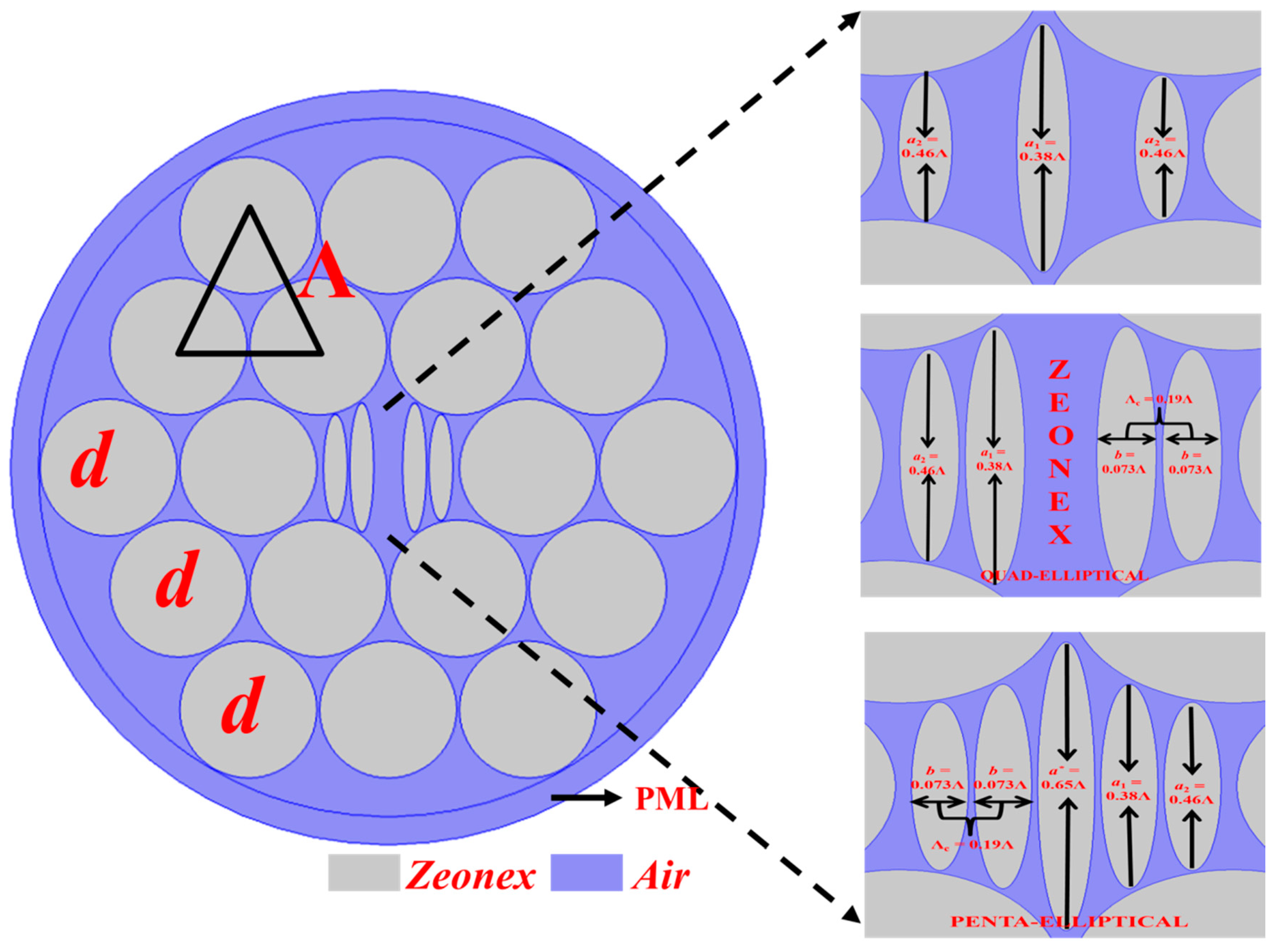
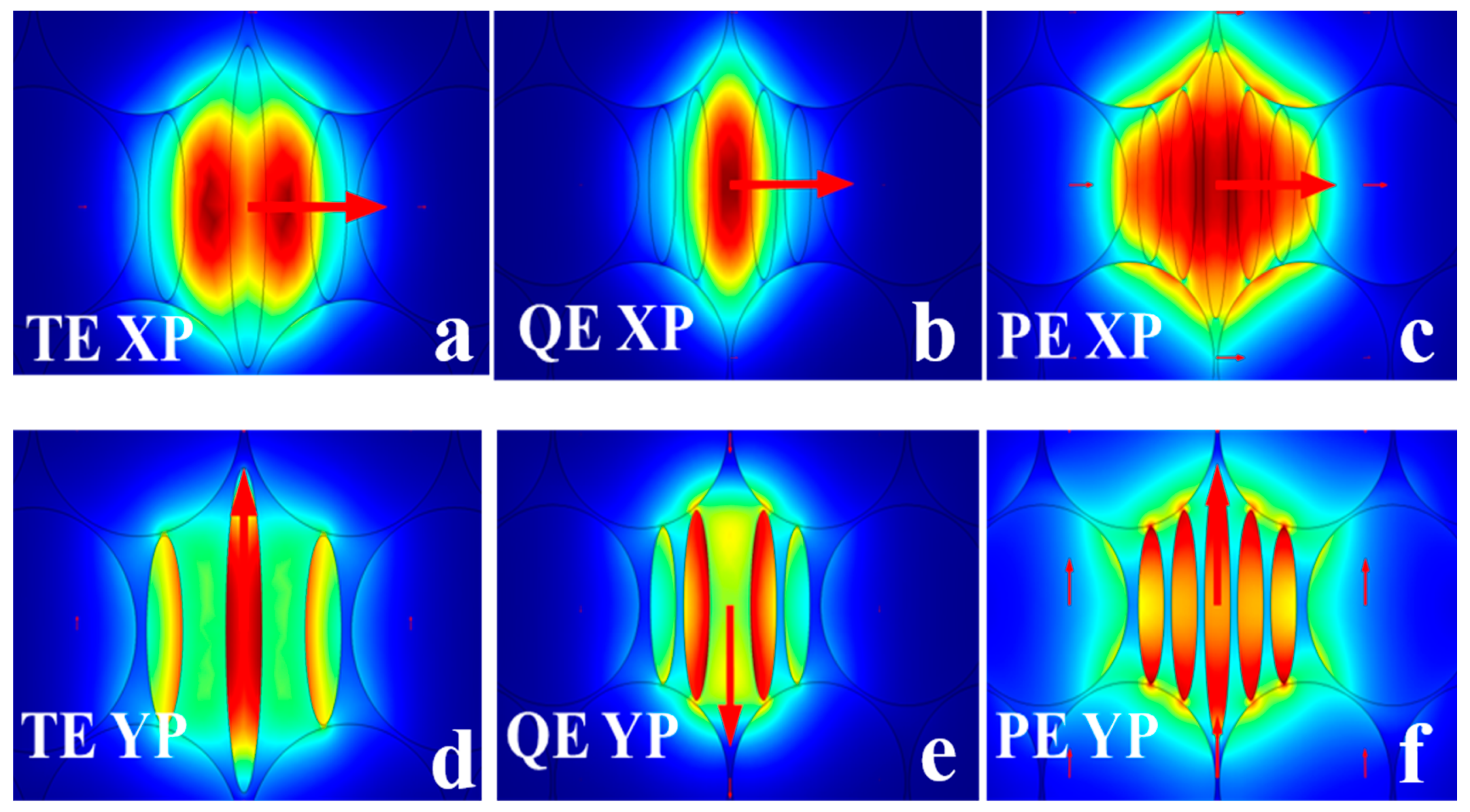
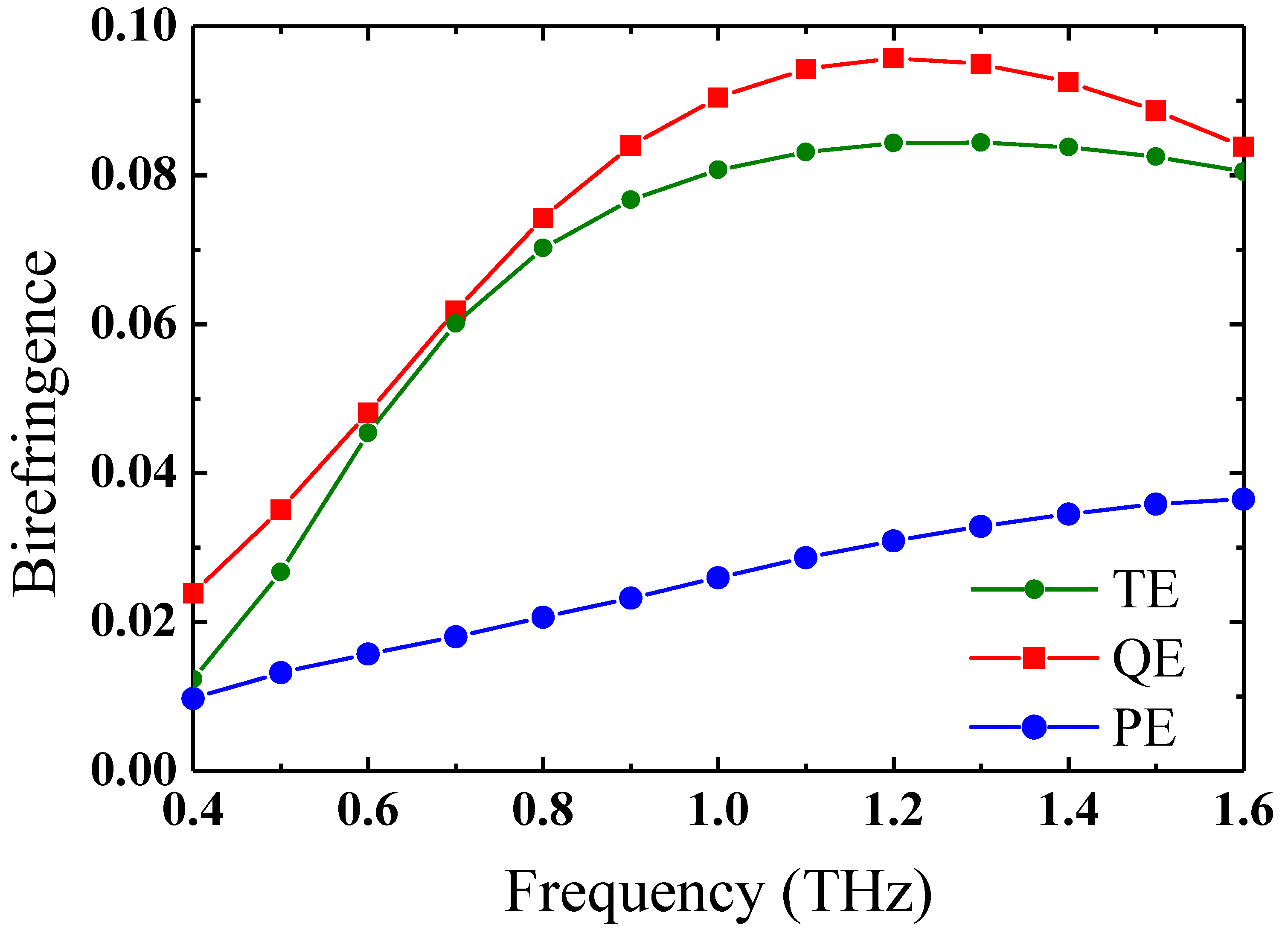
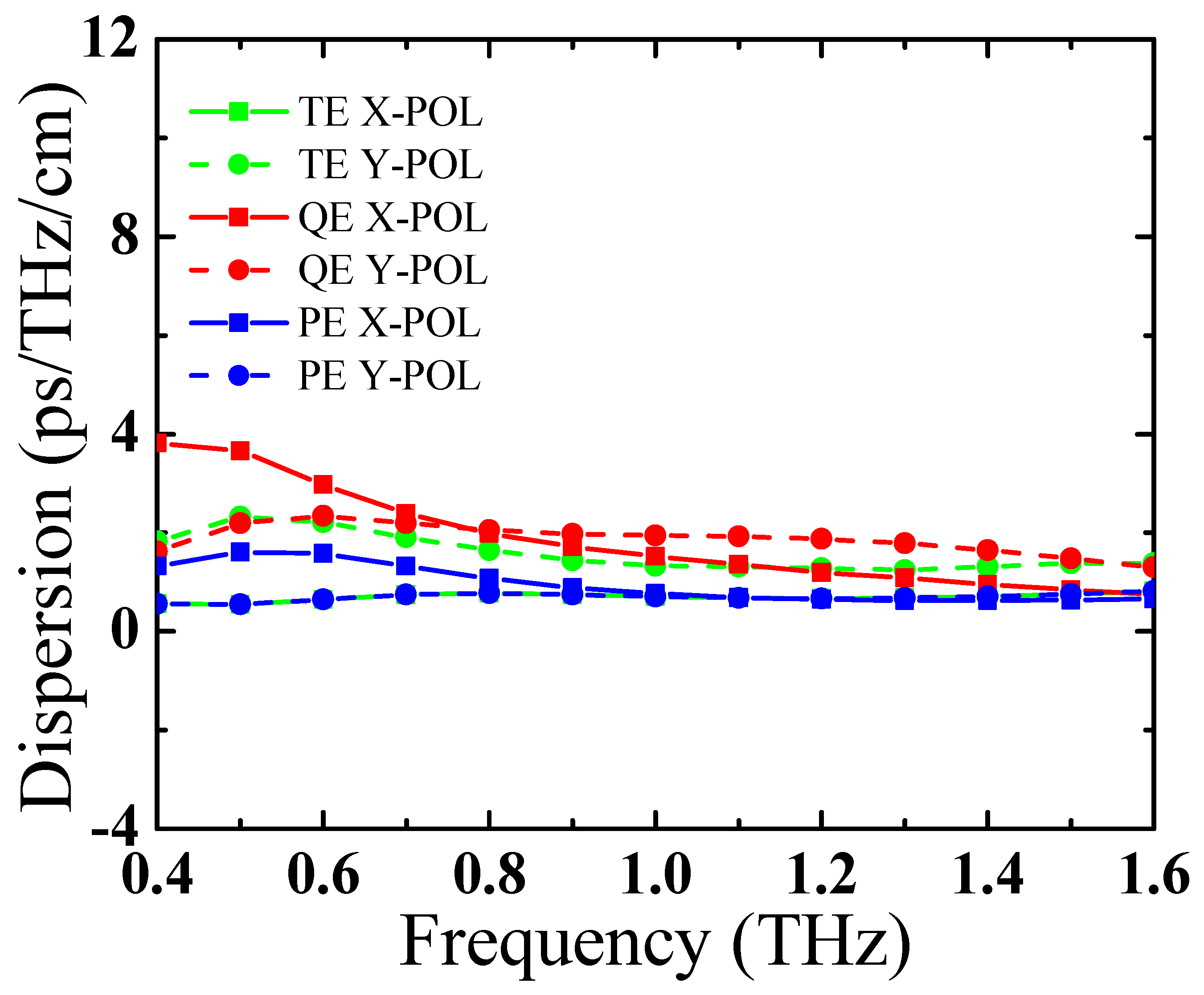
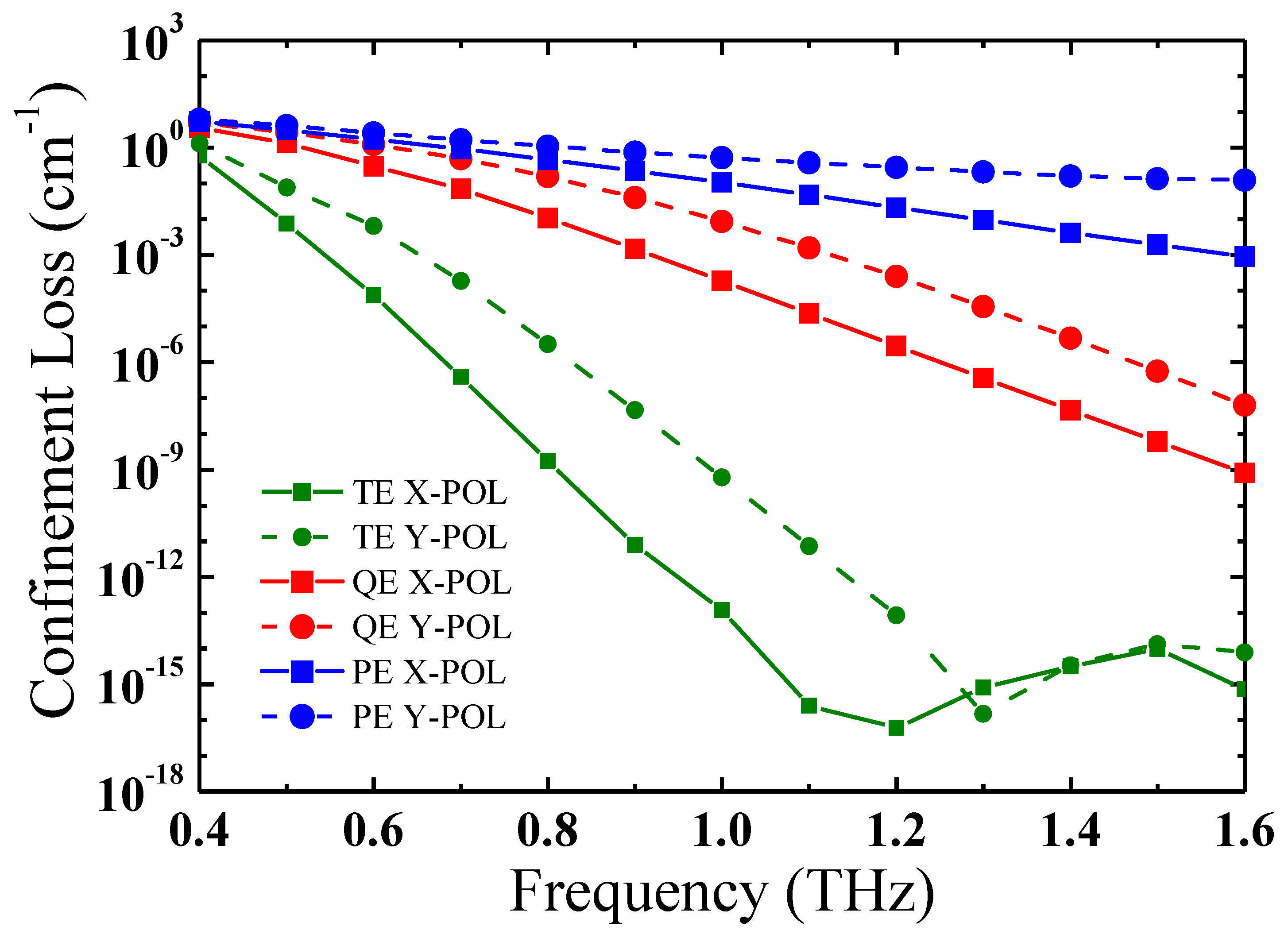
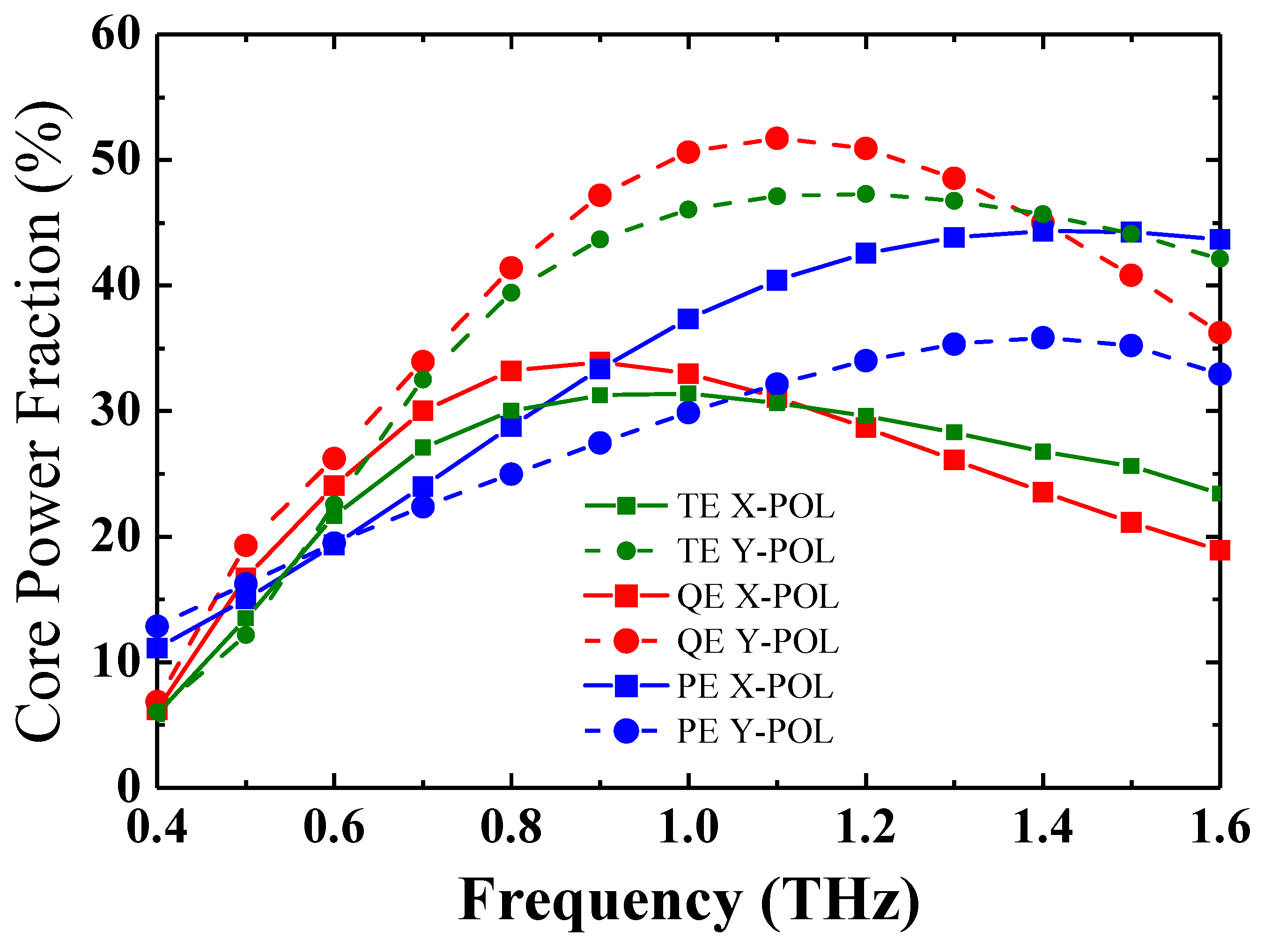
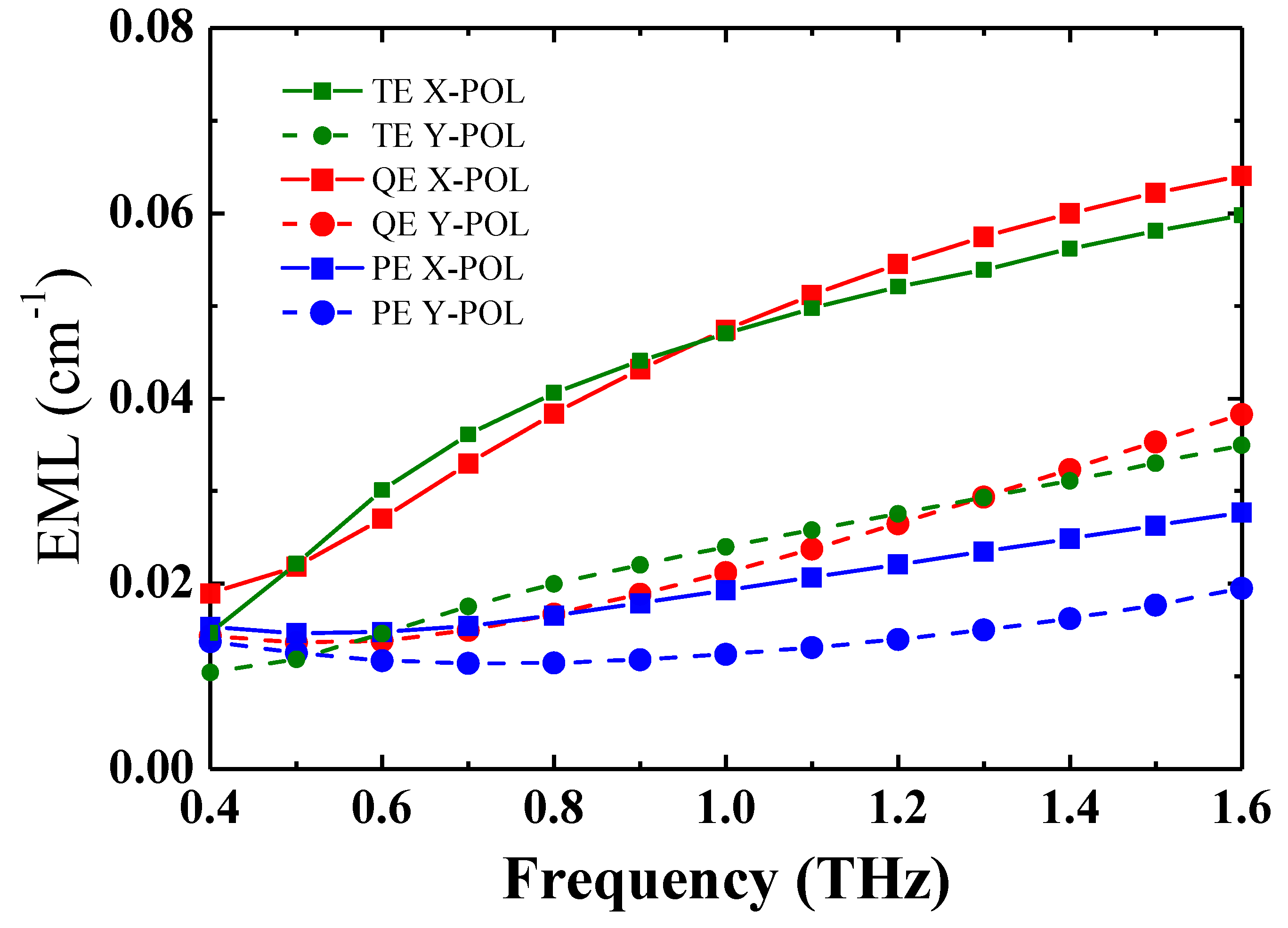
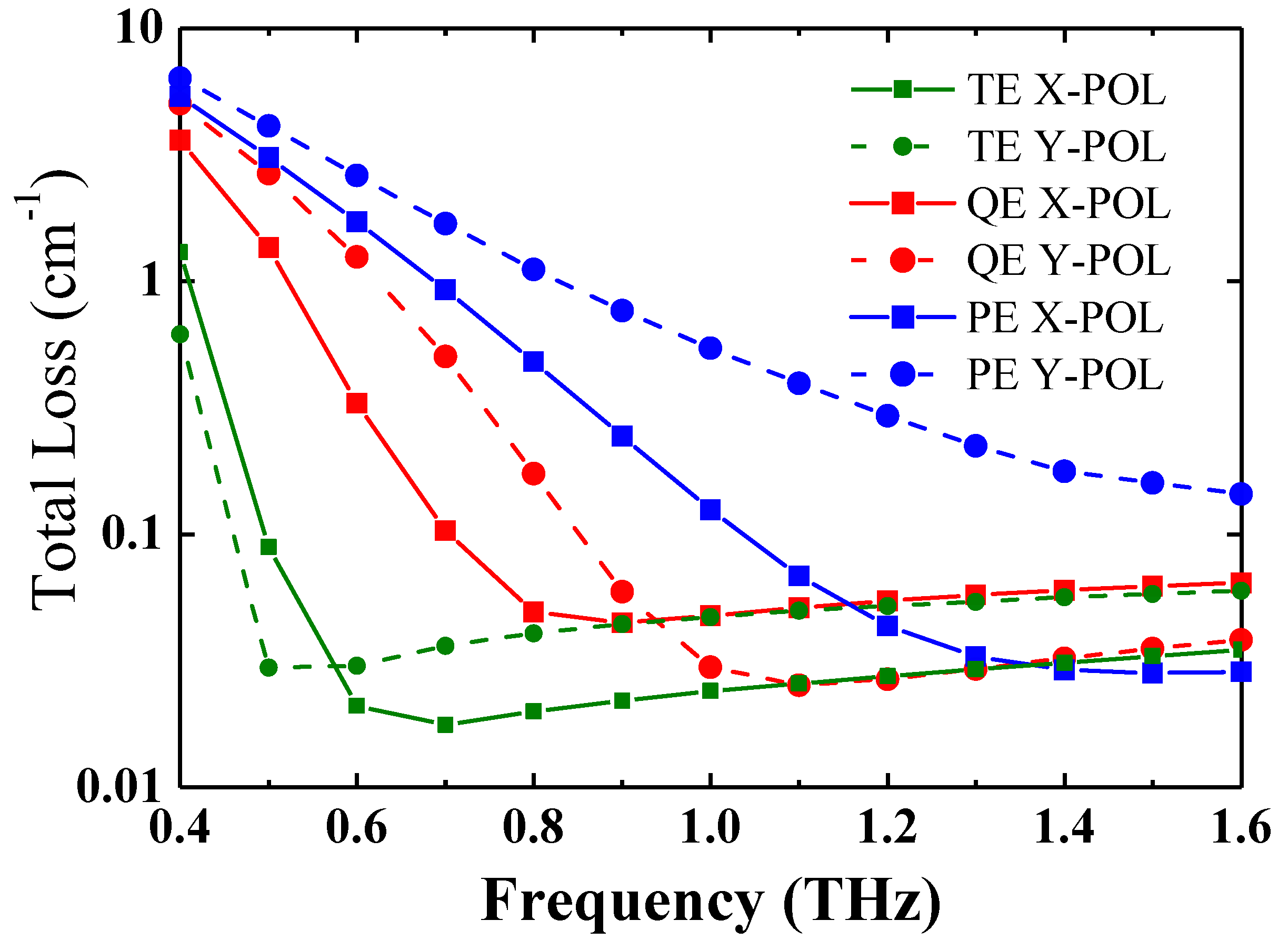
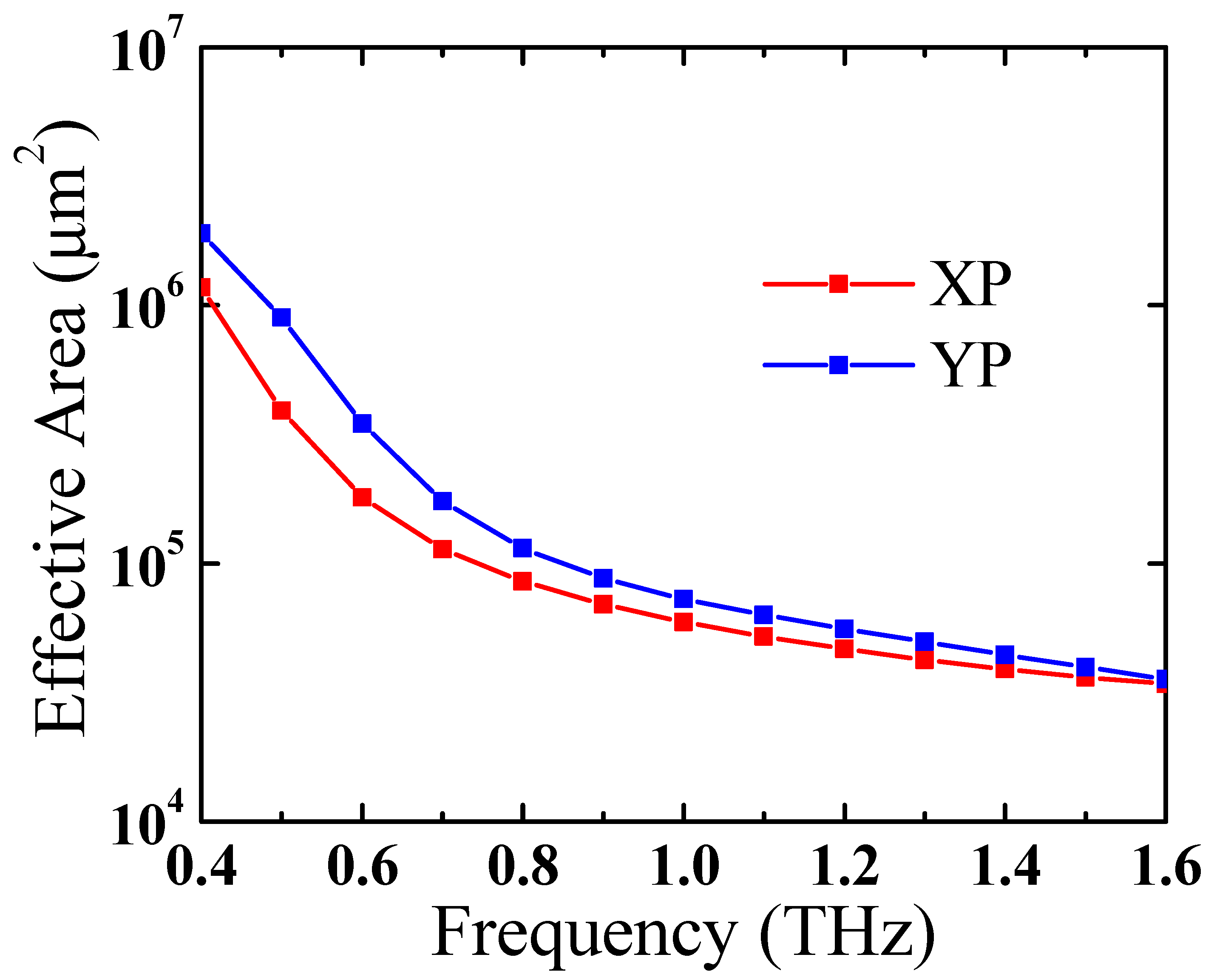
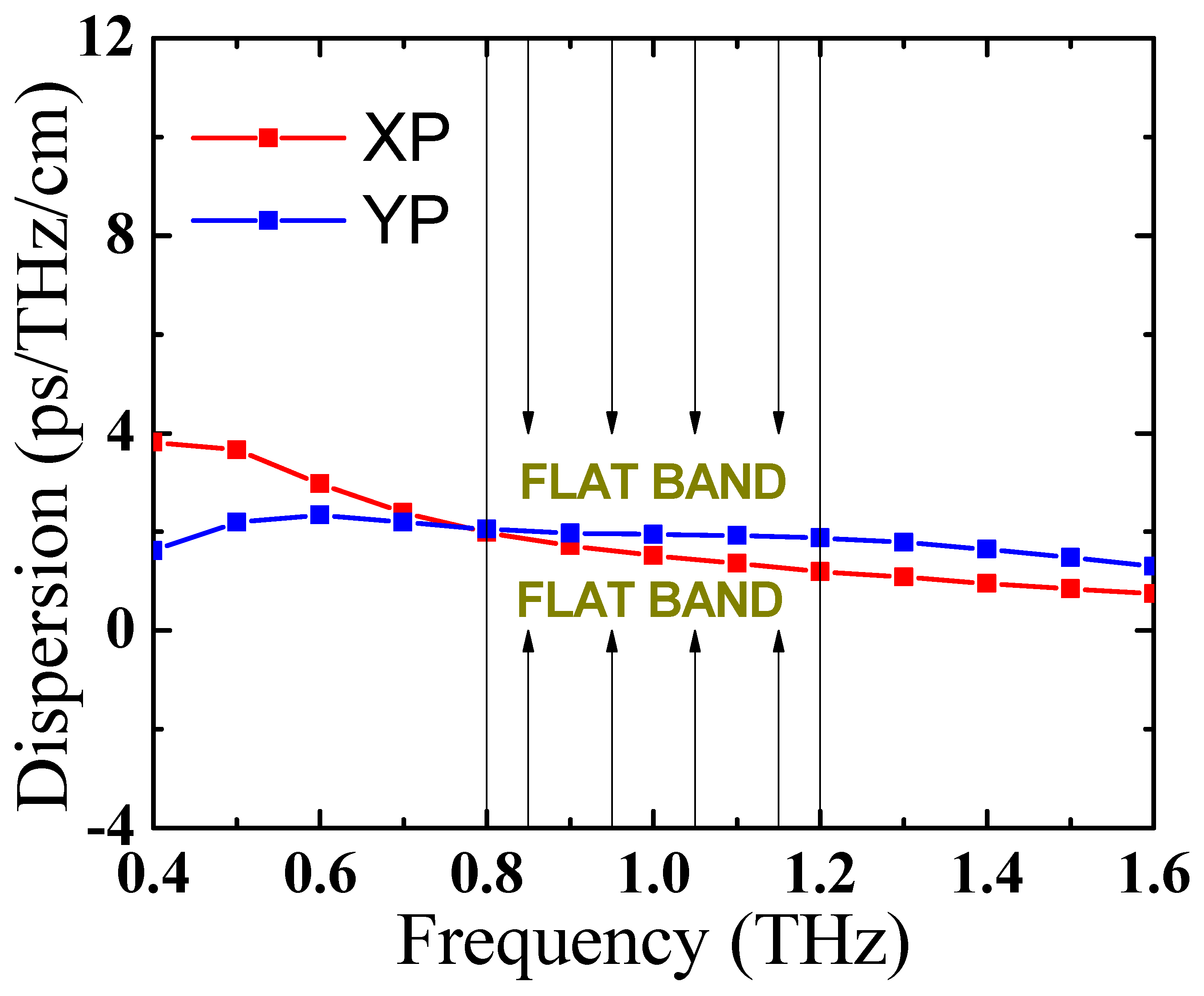
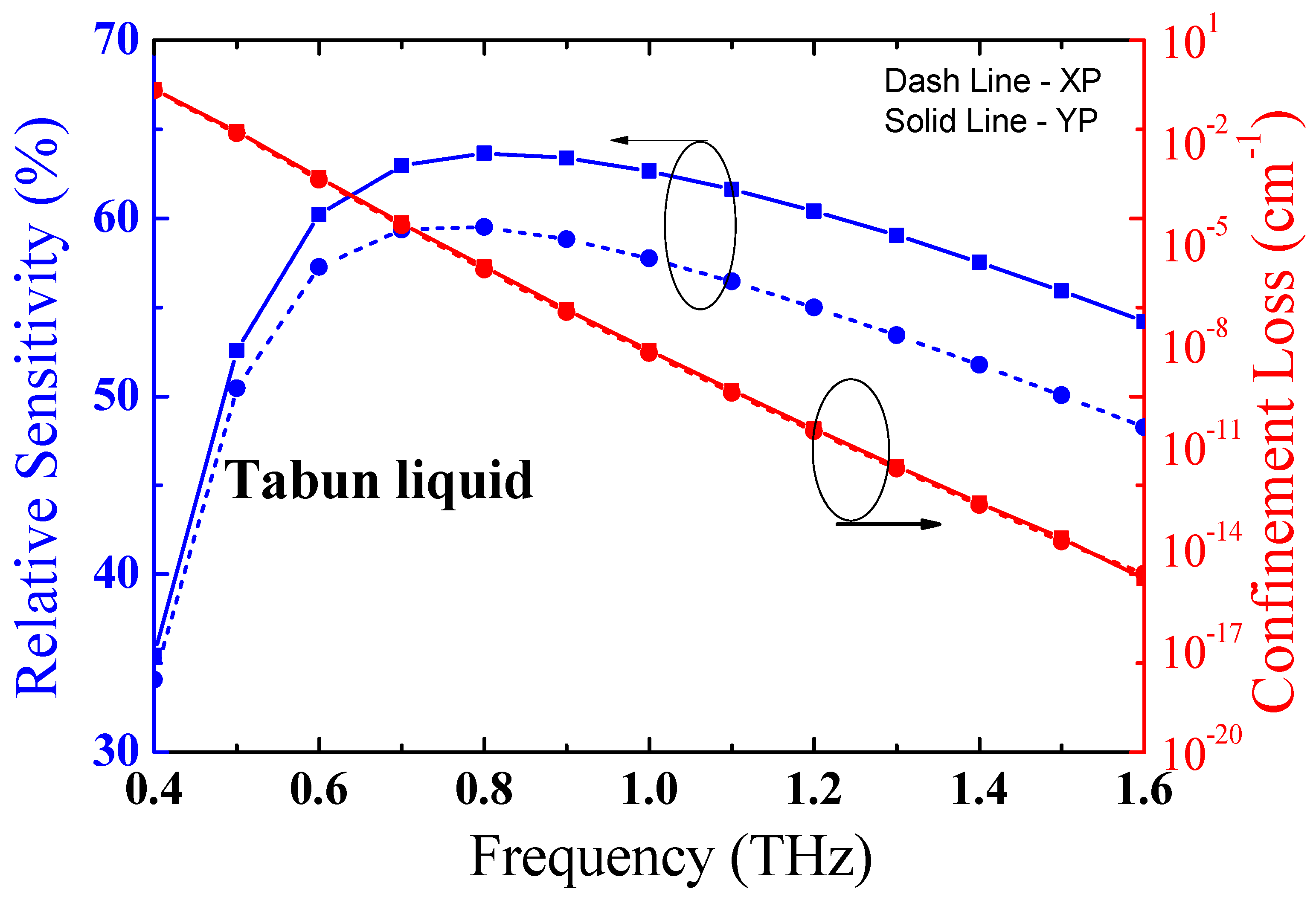

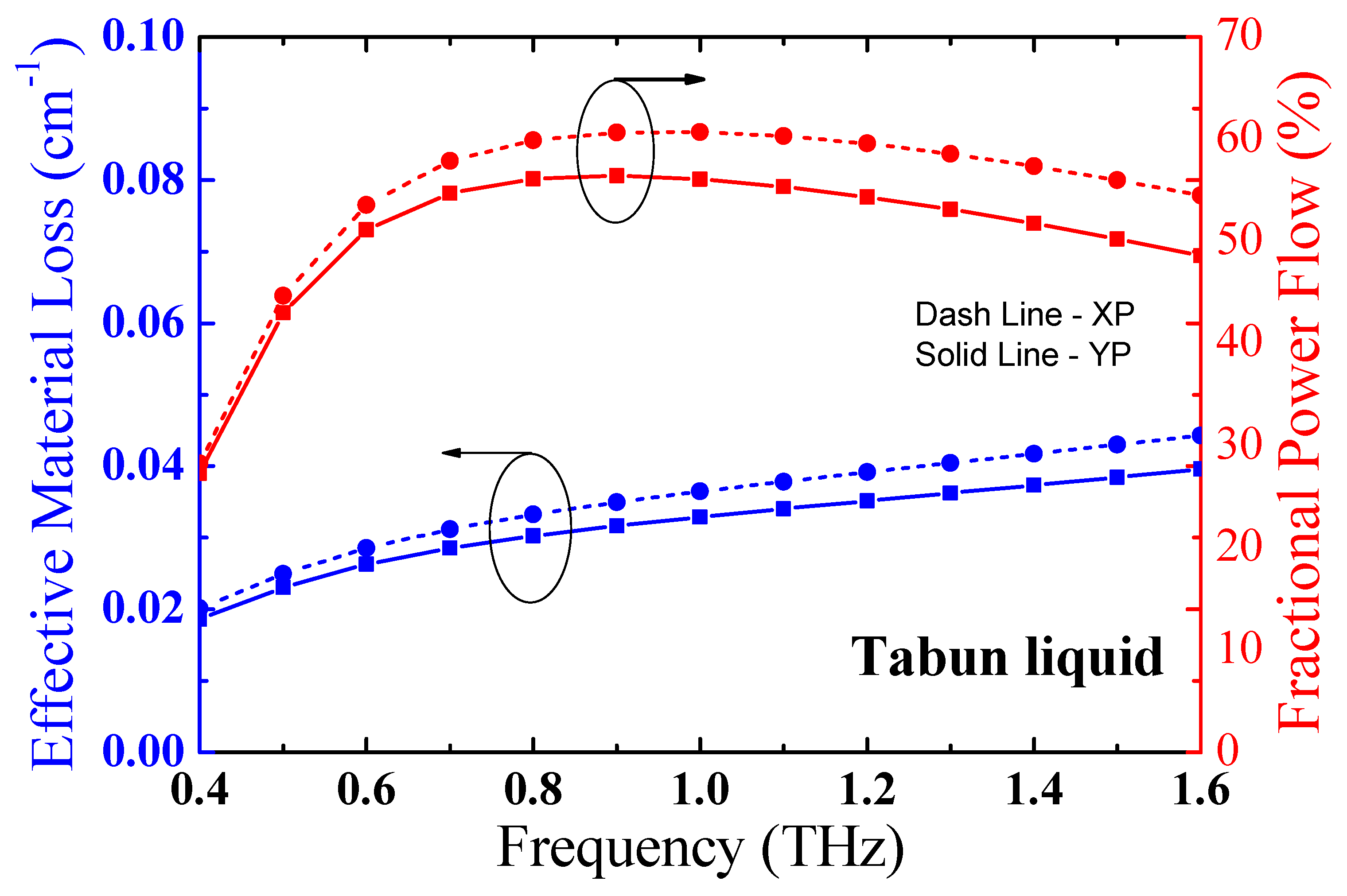
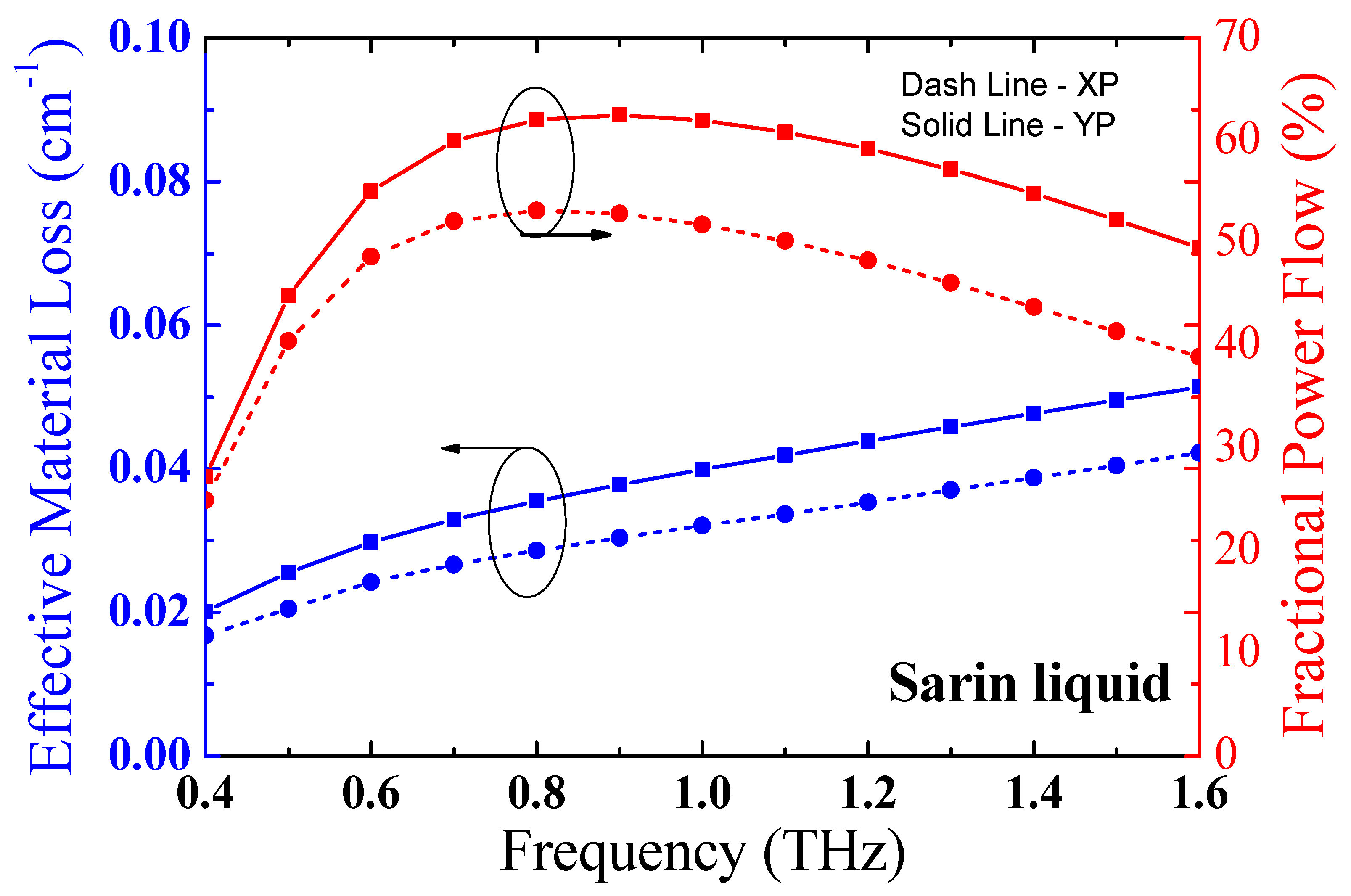
© 2019 by the authors. Licensee MDPI, Basel, Switzerland. This article is an open access article distributed under the terms and conditions of the Creative Commons Attribution (CC BY) license (http://creativecommons.org/licenses/by/4.0/).
Share and Cite
Yakasai, I.; Abas, P.E.; Kaijage, S.F.; Caesarendra, W.; Begum, F. Proposal for a Quad-Elliptical Photonic Crystal Fiber for Terahertz Wave Guidance and Sensing Chemical Warfare Liquids. Photonics 2019, 6, 78. https://doi.org/10.3390/photonics6030078
Yakasai I, Abas PE, Kaijage SF, Caesarendra W, Begum F. Proposal for a Quad-Elliptical Photonic Crystal Fiber for Terahertz Wave Guidance and Sensing Chemical Warfare Liquids. Photonics. 2019; 6(3):78. https://doi.org/10.3390/photonics6030078
Chicago/Turabian StyleYakasai, Izaddeen, Pg Emeroylariffion Abas, Shubi F Kaijage, Wahyu Caesarendra, and Feroza Begum. 2019. "Proposal for a Quad-Elliptical Photonic Crystal Fiber for Terahertz Wave Guidance and Sensing Chemical Warfare Liquids" Photonics 6, no. 3: 78. https://doi.org/10.3390/photonics6030078
APA StyleYakasai, I., Abas, P. E., Kaijage, S. F., Caesarendra, W., & Begum, F. (2019). Proposal for a Quad-Elliptical Photonic Crystal Fiber for Terahertz Wave Guidance and Sensing Chemical Warfare Liquids. Photonics, 6(3), 78. https://doi.org/10.3390/photonics6030078






